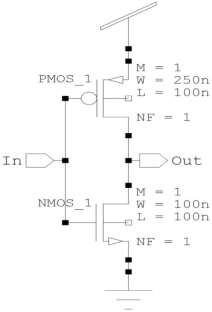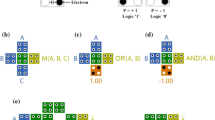Abstract
The field of VLSI is evergreen and always growing. Tremendous amount of work is done to embed more gates on a given chip area. This makes it difficult to remove the generated heat. This problem can be solved by using low power circuits. Adiabatic logic style which is advancement over CMOS in terms of power dissipation is a good solution suggested by researchers. In this paper an entirely new approach is presented to address this problem. The proposed circuit dissipates least power as compared to other power saving logic styles. A comparative analysis of all the three logic styles has been presented for better understanding. The circuits are implemented and simulated on Tanner V.13 using 90 nm technology.








Similar content being viewed by others
References
Shinghal D, Saxena A, Noor A (2013) Adiabatic logic circuits: a retrospect. MIT Int J Electron Commun Eng 3(2):108–114
Singh R, Mehra R (2013) Power efficient design of multiplexer using adiabatic logic. Int J Adv Eng Technol 6(1):246
Maini AK (2007) Digital electronics: principles, devices, and applications. Wiley, New York
Pecht M, Solomon R, Sandborn P, Wilkinson C, Daso D (2004) Obsolescence prediction and management. Parts selection and management. Wiley, New York, p 231
Teichmann P (2011) Adiabatic logic: future trend and system level perspective, vol 34. Springer Science & Business Media, New York
Athas WC, Svensson LJ, Koller JG, Tzartzanis N, Chou EY-C (1994) Low-power digital systems based on adiabatic-switching principles. IEEE Trans Very Large Scale Integr (VLSI) Syst 2(4):398–407
Razavi B (2002) Design of analog CMOS integrated circuits. Tata McGraw-Hill Education, New York
Moon Y, Jeong D-K (1996) An efficient charge recovery logic circuit. IEICE Trans Electron 79(7):925–933
Chandrakasan AP, Sheng S, Brodersen RW (1992) Low-power CMOS digital design. IEICE Trans Electron 75(4):371–382
Yano K, Yamanaka T, Nishida T, Saito M, Shimohigashi K, Shimizu A (1990) A 3.8-ns CMOS 16* 16-b multiplier using complementary pass-transistor logic. IEEE J Solid State Circuits 25(2):388–395
Veendrick HJM (1984) Short-circuit dissipation of static CMOS circuitry and its impact on the design of buffer circuits. IEEE J Solid State Circuits 19(4):468–473
Weste NHE, Eshraghian K (1985) Principles of CMOS VLSI design: a systems perspective. NASA STI/Recon technical report A 85
Watts RK (1989) Submicron integrated circuits. Wiley, New York
Kumar BD, Bharathi M (2013) Design of energy efficient arithmetic circuits using charge recovery adiabatic logic. Int J Eng Trends Technol 4(1):32–40
Reddy SG (2011) Power comparison of CMOS and adiabatic full adder circuit. arXiv preprint arXiv:1110.1549
Maksimovic D, Oklobdzija VG (1995) Clocked CMOS adiabatic logic with single AC power supply. In: ESSCIRC'95: twenty-first European solid-state circuits conference, IEEE, pp 370–373
Denker JS (1994) A review of adiabatic computing. In: Proceedings of 1994 IEEE symposium on low power electronics, IEEE, pp 94–97
Patel B, Kadam P (2015) Comparative analysis of adiabatic logic techniques. Int J Comput Appl 975:8887
Maksimovic D, Oklobdzija VG, Nikolic B, Current KW (2000) Clocked CMOS adiabatic logic with integrated single-phase powerclock supply. IEEE Trans Very Large Scale Integr (VLSI) Syst 8(4):460–463
Dickinson AG, Denker JS (1995) Adiabatic dynamic logic. IEEE J Solid State Circuits 30(3):311–315
Vetuli A, Pascoli SDI, Reyneri LM (1996) Positive feedback in adiabatic logic. Electron Lett 32(20):1867–1869
Liu F, Lau KT (1998) Pass-transistor adiabatic logic with NMOS pull-down configuration. Electron Lett 34(8):739–741
Kim S, Papaefthymiou MC (1999) Single-phase source-coupled adiabatic logic. In: Proceedings of the 1999 international symposium on low power electronics and design, pp 97–99
Hu J, Tiefeng Xu, Li H (2005) A lower-power register file based on complementary pass-transistor adiabatic logic. IEICE Trans Inf Syst 88(7):1479–1485
Author information
Authors and Affiliations
Corresponding author
Rights and permissions
About this article
Cite this article
Sharma, S., Devasia, R. & Sharma, G. A novel low power and highly efficient inverter design. Int. j. inf. tecnol. 12, 1111–1116 (2020). https://doi.org/10.1007/s41870-020-00512-x
Received:
Accepted:
Published:
Issue Date:
DOI: https://doi.org/10.1007/s41870-020-00512-x




